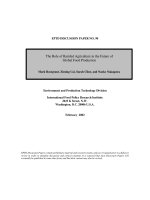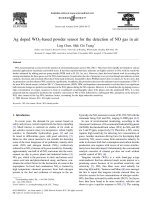Constructive role of internal noise for the detection of weak signal in cell system
Bạn đang xem bản rút gọn của tài liệu. Xem và tải ngay bản đầy đủ của tài liệu tại đây (373.1 KB, 4 trang )
ACTA PHYSICO-CHIMICA SINICA
Volume 24, Issue 12, December 2008
Online English edition of the Chinese language journal
Cite this article as: Acta Phys. -Chim. Sin., 2008, 24(12): 2203−2206.
Received: July 30, 2008; Revised: September 15, 2008.
*Corresponding author. Email: ; Tel: +86551-3602908.
The project was supported by the National Natural Science Foundation of China (20433050, 20673106).
Copyright © 2008, Chinese Chemical Society and College of Chemistry and Molecular Engineering, Peking University. Published by Elsevier BV. All rights reserved.
Chinese edition available online at www.whxb.pku.edu.cn
ARTICLE
Constructive Role of Internal Noise for the Detection of
Weak Signal in Cell System
Hongying Li
1,2
Juan Ma
2
Zhonghuai Hou
2,
* Houwen Xin
2
1
Department of Chemistry and Chemical Engineering, Hefei Teachers College, Hefei 230026, P. R. China;
2
Department of Chemical Physics, University of Science and Technology of China, Hefei 230026, P. R. China
Abstract: Taking into account the existence of internal noise in small scale biochemical reaction systems, we studied how the
internal noise would influence the detection of weak external signal in the cell system using chemical Langevin equation. The weak
signal was too small to, separately, fire calcium spikes for the cell. We found that, near the Hopf bifurcation point, the internal noise
could help the calcium oscillation signal cross a threshold value, and at an optimal internal noise level, a resonance occurred among
the internal noise, the internal noise-induced calcium oscillations, and the weak signal, so as to enhance intensively the ability of the
cell system to detect the weak signal. Since the internal noise was changed via the cell size, this phenomenon demonstrated the
existence of an optimal cell size for the signal detection. Interestingly, it was found that the optimal size matched well with the real
cell size, which was robust to external stimulus, this was of significant biological meaning.
Key Words:
Internal noise; Detection of weak signal; Calcium oscillation; Resonance
Noise is usually considered a nuisance, degrading the per-
formance of dynamic systems. But in some nonlinear systems,
the presence of noise can enhance the ability of the system to
detect weak signals. This phenomenon of noise-enhanced de-
tection of weak signals has been studied experimentally and
theoretically in various systems. For example, this phenome-
non was reported in the mechanoreceptive system in cray-
fish
[1,2]
and dogfish
[3]
, human tactile sensation
[4]
, visual per-
ception
[5]
, cricket sensory system
[6]
, human brain system
[7,8]
,
chemical reaction system
[9]
, neuron system
[10,11]
, hair bundle
system
[12]
and so on. The uniform feature in these systems is
the concurrence of a threshold, a subthreshold stimulus, and
the noise. There exists an optimal level of noise that results in
the maximum enhancement, whereas further increases or de-
creases in the noise intensity only degrade detectability or in-
formation contents. The threshold is ubiquitous in nature, es-
pecially in some biological systems, and these systems may
receive external stimulus all the time. Usually, the stimulus is
by itself below the threshold, never crosses it, and is therefore
undetectable, whereas when the system is embedded with
noise, threshold crossing occurs with great probability so as to
intensively enhance the ability of the system to detect weak
signals.
However, most of the studies so far only account for exter-
nal noise. With the recent development of studies in mesos-
copic chemical oscillation systems, an even important source
of noise, internal noise, has attracted considerable attention,
which results from the random fluctuations of the stochastic
reaction events in systems. It is generally accepted that the
strength of the internal noise scales as 1/
Ω , where Ω is the
system size. In the macroscopic limit where Ω is infinite, the
internal noise can be ignored. However, in small systems,
such as cellular and subcellular systems, the number of reac-
tion molecules is very low, so the internal noise must be taken
into account. Recently, the important effects of internal noise
in chemical oscillation reaction systems have gained growing
attention. For example, Shuai and Jung
[13,14]
demonstrated that
optimal intracellular calcium signaling appeared at a certain
size or distribution of the ion channel clusters. Ion channel
clusters of optimal sizes can enhance the encoding of a sub-
threshold stimulus
[15,16]
. In recent studies, Xin′s group also
found such a phenomenon in the Brusselator model
[17]
, cir-
Hongying Li et al. / Acta Physico-Chimica Sinica, 2008, 24(12): 2203
−
2206
cadian clock system
[18]
, calcium signaling system
[19,20]
, neuron
system
[21]
, synthetic gene network
[22]
, catalysis system
[23]
and
so on. There exists an optimal system size (that is internal
noise value), at which the stochastic oscillation shows the best
performance. They call this phenomenon “internal noise sto-
chastic resonance” or “system size resonance”. Therefore, a
basic question is: will the internal noise influence the signal
detection in small systems?
In the present article, via the inositol 1,4,5-trisphosphate-
calcium cross-coupling (ICC) cell model, we investigated how
the internal noise would influence the detection of weak sig-
nal.
1
1 Model
The model used in the present article describes the dynam-
ics of calcium ions in cytosol, which was first produced by
Meyer and Stryer in 1991
[24]
. If the internal noise is ignored,
the time evolution of the species is governed by the following
macroscopic kinetics
[25]
:
pumpchannel
d
d
d
d
JvJ
t
y
t
x
−=−= (1a)
Duk
t
u
−=
PLC
d
d
(1b)
vxEvF
t
v
vv
4
)(1
d
d
−−=
(1c)
where x, y, u represent the concentration of three key species:
the cytosolic Ca
2+
(Ca
i
), the calcium ions sequestered in an in-
tracellular store (Ca
s
), and the inositol 1,4,5-trisphosphate
(IP
3
), respectively; v denotes the fraction of open channels
through which the sequestered calcium is released into cytosol;
D, F
v
, and E
v
are constants that are relative to the variable u
and v; the flux J
channel
is associated with the release of seques-
tered calcium from an internal store, the fulx J
pump
corresponds
to calcium sequestration, k
PLC
is the rate of IP
3
production,
which are given by
y
Ku
Au
J
⎥
⎦
⎤
⎢
⎣
⎡
+
=
4
1
4
channel
)(
,
2
2
2
2
pump
Kx
Bx
J
+
=
,
⎥
⎦
⎤
⎢
⎣
⎡
++
−=
)1)((
1
3
3
PLC
RKx
K
Ck
(2)
where A, B, C, K
1
, K
2
, and K
3
are constants. Choosing R,
which represents the fraction of activated cell surface recep-
tors, as an adjustable parameter. See Ref.[25] for the detailed
descriptions and values of the parameters in Eqs.(1) and (2).
However, for a typical living cell, such a deterministic de-
scription is no longer valid due to the existence of consider-
able internal noise. Instead, a mesoscopic stochastic model
must be used. To investigate the effect of internal noise, basi-
cally, one can describe the reaction system as a birth-death
stochastic process governed by a chemical master equation.
But there is no procedure to solve this master. A widely used
simulation algorithm has been introduced by Gillespie
[26]
,
which stochastically determines what is the next reaction step
and when it will happen according to the transition rate of
each reaction process. For the current model, the reactions in
the cell can be grouped into four elementary processes ac-
cording to Ref.[27], the processes and their reaction rates are
defined in Table 1 (note that the reaction rates are proportional
to the system size Ω), where X=xΩ, U=uΩ. X and U are the
numbers of the cytosolic Ca
2+
(Ca
i
)
and the IP
3
production,
respectively.
This simulation method is exact because it exactly accounts
for the stochastic nature of the reaction events, but it is rather
time-consuming if the system size is large. To solve this
problem, Gillespie developed chemical Langevin equation
(CLE)
[28]
. We have also shown that it is applicable to use the
CLE to qualitatively study the effect of the internal noise
[17−20]
.
According to Gillespie
[28]
, the CLE for the current model is as
follows:
[]
)()()(
1
d
d
221121
tataaa
Ωt
x
ξξ
−+−= (3a)
[]
)()()(
1
d
d
443343
tataaa
Ωt
u
ξξ
−+−= (3b)
()
vxEvF
t
v
vv
4
1
d
d
−−= (3c)
where ξ
i
(t) (i=1, 2, 3, 4) are Gaussian white noises with
<ξ
i
(t)>=0 and <ξ
i
(t)ξ
i
(t′)>=δ
ij
δ(t−t′). Because the reaction rates
(a
i
) are proportional to Ω, the internal noise item in the CLE
scales as 1/
Ω .
Now, we consider that the cell system is subjected to a
weak periodic signal, which probably comes from an external
stimulus. Then, the system′s dynamics can be described as:
[]
)()()(
1
d
d
221121
tataaa
Ωt
x
ξξ
−+−=
) π2sin( tM
ϖ
+
(4a)
[]
)()()(
1
d
d
443343
tataaa
Ωt
u
ξξ
−+−= (4b)
vxEvF
t
v
vv
4
)1(
d
d
−−=
(4c)
where M and
ϖ
are the amplitude and frequency of the
weak signal, respectively. In the following parts, we will use
equations (4a−4c) as our stochastic model for numerical
simulation to study the effect of the internal noise on the de-
tection of the weak signal.
2 Simulation and results
We tune the control parameter R=0.605, which is very close
to the Hopf bifurcation point designated by the macroscopic
kinetics, but the deterministic system does not sustain oscilla-
tions (see Ref.[25] for more detailed description of the bifur-
Table 1 Stochastic processes and corresponding rates for
intracellular Ca
2+
dynamics
Stochastic process Reaction rate
X→X+1 a
1
=ΩνJ
channel
X→X−1 a
2
=ΩJ
pump
U→U+1 a
3
=Ωk
PLC
U→U−1 a
4
=ΩDu
Hongying Li et al. / Acta Physico-Chimica Sinica, 2008, 24(12): 2203
−
2206
cation action). One should note that it is always near this
critical point, at which noise can play constructive roles. For
the weak periodic signal, we choose M=1.5 and ω=
c
ϖ
=0.505
Hz,
c
ϖ
is the frequency of the intrinsic oscillation of the cell.
This signal itself is too weak to excite calcium spikes sepa-
rately (the threshold we choose here is x=1.2 μmol·L
−1
) and is
therefore undetectable. Whereas when the internal noise is
considered, threshold crossing occurs with great probability,
and at an optimal noise level, a resonance occurs among the
noise, the noise-induced oscillation, and the signal so as to in-
tensively enhance the ability of the cell system to detect the
weak signal. Fig.1 shows the time series of the variable x for
different system sizes. For large system size Ω, corresponding
to the low level of internal noise, the system exhibits sub-
threshold oscillations with small amplitude (Fig.1(a)). Irregu-
lar superthreshold spikes appear occasionally when Ω de-
creases (Fig.1(b)). When Ω decreases further, the superthresh-
old spikes appear with great probability, and the regularity of
the spikes remains well (Fig.1(c)), below which the spikes
become irregular again (Fig.1(d)).
To measure the relative regularity of the calcium spike train
quantitatively, we introduce a coherence measure (CM), which
is defined as the mean value of the spike interval T normalized
to the mean root, namely,
22
CM
T
TT
<>
=
<>− <>
[9]
. Note
that a spike occurs when the intracellular calcium concentra-
tion crosses a certain threshold value from below, and it turns
out that the threshold value can vary in a wide range without
altering the resulting spiking dynamics. The measure CM has
been frequently used to quantify the regularity of stochastic
spike trains, and it could be of biological significance because
it is related to the time precision of information processing. A
larger value of CM means more closeness of the spike train to
a periodic one, where CM is obviously ∞. The dependence of
CM on system size is plotted in Fig.2. A clear maximum is
present for system size Ω (≈10
3
μm
3
),
which demonstrates the
occurrence of “system size resonance”. It is interesting to note
that this size is of the same order as the living cells in vivo.
From the CLE, one notes that the internal noise item is pro-
portional to 1/
Ω if all other parameters are fixed. Therefore,
an optimal system size implies an optimal level of internal
noise. This constructive role of internal noise recalls one the
well-known phenomenon of stochastic resonance (SR), so it
also can be called “internal noise stochastic resonance”. The
cell system is likely to exploit the internal noise to enhance the
ability to detect weak signals with the aid of system size reso-
nance.
In the case of a fixed threshold (here we choose x=1.2
μmol·L
−1
) and variable system size, the detection of the weak
signal in a cell system will be influenced mainly by three fac-
tors: the signal frequency, the signal amplitude, and the con-
trol parameter. Previous study
[15]
has shown that, in response
to a weak signal, a resonance among the noise, the noise-in-
duced oscillation, and the signal can intensively enhance the
ability of the system in detection of the weak signal, especially
when the frequency of the signal is around that of the intrinsic
oscillation of the system. And, because the frequency of the
intrinsic oscillation can be adjusted by the internal or external
modulations, the system can effectively detect and process
signals with various frequencies. This is of significant bio-
logical meaning. In the following parts, we will mainly dis-
cuss the effect of the signal amplitude and control parameter
on the signal detection.
Fig.3 shows the dependence of CM on system size with
various signal amplitudes. We can see that for three given
amplitudes of the input weak signal, there all exists an optimal
system size, and the position of the optimal size remains
nearly unchanged at Ω≈10
3
μm
3
.
We have also studied how the signal detection behavior
depends on the value of control parameter (R). This is shown
in Fig.4. When the distance from the deterministic Hopf bi-
furcation point increases, first, the maximum CM and the op-
timal system size become smaller; and then, when the control
parameter becomes even larger, although the maximum CM
continues to become smaller, the position of the optimal size
Fig.1 Time series of the variable x for different system sizes (Ω)
Ω/μm
3
: (a) 10
6
, (b) 10
5
, (c) 10
3
, (d) 200; The broken line denotes
the threshold chosen.
Fig.2 Coherence measure (CM) as a function of system size
Hongying Li et al. / Acta Physico-Chimica Sinica, 2008, 24(12): 2203
−
2206
remains unchanged at Ω≈10
3
μm
3
.
3
3 Conclusions
To summarize, we have studied the influence of internal
noise on the detection of the weak signal. We show that, near
the Hopf bifurcation point, instead of trying to resist the in-
ternal molecular noise, living cell systems may have learned
to exploit the internal noise to intensively enhance the ability
to detect weak signals. The performance of calcium oscillation
undergoes a maximum with the variety of the system size Ω,
indicating the occurrence of “system size resonance”. Inter-
estingly, we find that the position of the optimal size remains
at Ω≈10
3
μm
3
for a wide range of signal amplitudes and con-
trol parameters, which is of the same order of real living cells
in vivo. Since the internal noise in living cell systems cannot
be ignored and the system may often receive weak signals, our
findings may have quite significant implications for living cell
systems and may imply the ubiquitous importance of internal
noise in functioning processes in living organisms.
References
1 Douglass, J. K.; Wilkens, L.; Pantazelou, E.; Moss, F. Nature,
1993, 365: 337
2 Pei, X.; Wilkens, L. A.; Moss, F. J. Neurophysiol., 1996, 76:
3002
3 Braun, H. A.; Wissing, H.; Schä fer, K.; Hirsch, M. C. Nature,
1994, 367: 270
4 Collins, J. J.; Imhoff, T. T.; Grigg, P. Nature, 1996, 383: 770
5 Simonotto, E.; Riani, M.; Seife, C.; Roberts, M.; Twitty, J.; Moss,
F. Phys. Rev. Lett., 1997, 78: 1186
6 Levin, J. E.; Miller, J. P. Nature, 1996, 380: 165
7 Kitajo, K.; Nozaki, D.; Ward, L. M.; Yamamoto, Y. Phys. Rev.
Lett., 2003, 90: 218103
8 Hidaka, I.; Nozaki, D.; Yamamoto, Y. Phys. Rev. Lett., 2000, 85:
3740
9 Miyakawa, K.; Tanaka, T.; Isikawa, H. Phys. Rev. E, 2003, 67:
066206
10 Yu, Y. G.; Wang, W.; Wang, J. F.; Liu, F. Phys. Rev. E, 2001, 63:
021907
11 Baltanás, J. P.; Casado, J. M. Phys. Rev. E, 2002, 65: 041915
12 Comalet, S.; Duke, T.; Jülicher, F.; Prost, J. Proc. Natl. Acad. Sci.
U.S.A., 2000, 97: 3183
13 Shuai, J. W.; Jung, P. Phys. Rev. Lett., 2
002
, 88: 068102
14 Shuai, J. W.; Jung, P. Proc. Natl. Acad. Sci. U.S.A., 2003, 100:
506
15 Schmid, G.; Goychuk, I.; Hänggi, P. Europhys. Lett., 2001, 56: 22
16 Schmid, G.; Goychuk, I.; Hänggi, P. Membrane clusters of ion
channels: size-effects for stochastic resonance. In: Statistical
mechanics of compex networks. Heidelberg/Berlin: Springer,
2003, Vol.625: 195−206
17 Hou, Z. H.; Xin, H. W. ChemPhysChem, 2004, 5: 407
18 Hou, Z. H.; Xin, H. W. J. Chem. Phys., 2003, 119: 11508
19 Li, H. Y.; Hou, Z. H.; Xin, H. W. Phys. Rev. E, 2005, 71: 061916
20 Li, H. Y.; Hou, Z. H.; Xin, H. W. Chem. Phys. Lett., 2005, 402:
444
21 Wang, M. S.; Hou, Z. H.; Xin, H. W. ChemPhysChem, 2004, 5:
1602
22 Wang, Z. W.; Hou, Z. H.; Xin, H. W. Chem. Phys. Lett., 2005,
401: 307
23 Gong, Y. B.; Hou, Z. H.; Xin, H. W. Sci. China Ser. B, 2005, 48:
395
24 Meyer, T.; Stryer, L. Annu. Rev. Biophys. Biophys. Chem., 1991,
20: 153
25 Schreiber, I.; Hasal, P.; Marek, M. Chaos, 1999, 9: 43
26 Gillespie, D. T. J. Phys. Chem.,
1977, 81: 2340
27 Gracheva, M. E.; Toral, R.; Gunton, J. D. J. Theor. Biol., 2001,
212: 111
28 Gillespie, D. T. J. Chem. Phys., 2000, 113: 297
Fig.3 Dependence of coherence measure on system size with
different signal amplitudes (M)
Fig.4 Coherence measure as a function of system size for
different control parameters (R)









